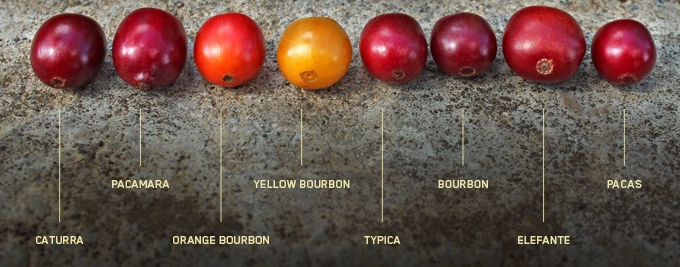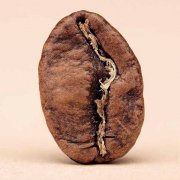What kinds of coffee do you have? Talk about some common varieties and their iconic taste
In the class of the coffee roaster training class, the proportion of the theory course is about 40%. Most of the time is operated and practiced by the students themselves. The college uses the Korean Tae-hwan roaster for training, and the students analyze the results of the cup test. Compare, adjust and summarize one by one. When it comes to the varieties of coffee trees in the theory class, in fact, we can talk a lot, but it is only used as a discrimination of coffee flavor. So we don't talk about it so complicated, just talk about some common varieties and their iconic taste.
1. Robusta (Robusta): commercial disease-resistant variety, mainly growing in hot areas, with high yield and high disease resistance. Bitter taste, no sour taste, bad taste more, but because of the high yield so its price is very cheap; Arabica (Arabica species), is a large population, different from Robusta (Robusta), all the following varieties are Arabica.
2. Typica (Tibica): one of the earliest varieties of coffee, mainly found in Africa, island countries and some countries in Central America. Generally speaking, Typica coffee has a charming and high aroma, with natural floral aroma, soft and pleasant acidity, but not good thickness.
3. Bourbon (bourbon): one of the earliest varieties of coffee, which is now more common in South America and still exists in Africa. General Bourbon coffee has a pleasant sour taste, high acidity and a certain alcohol thickness.
4. Caturra (Kaddura), a direct variety of Bourbon, is mainly cultivated in Central and South America. It has a higher yield than the original Bourbon, has soft acidity, pure and clean taste, and generally has some nutty flavor.
5. Mundo Novo (New World), a hybrid of Typica and Bourbon, is more common in Brazil, with high yield, high disease tolerance and general taste.
6. Catuai (Kaduai), a hybrid of Caturra and Mundo Novo, is more common in Central and South America. It combines the advantages of Caturra and Mundo Novo, and its taste is slightly better than Mundo Novo.
7. Sl28 and Sl34, Kenya's own varieties, show the iconic taste of Kenyan coffee. Charming sour, cocoa, high acidity; Sl28 also has a high alcohol thickness.
8. Maragogype and Pacamara (like beans and Pacamara) are both large varieties of beans, so they are called elephant beans. In recent years, it is mainly found in El Salvador, with large beans and good appearance, good taste balance and low acidity.
9. Geisha, the most famous variety today, has different opinions about its origin, some people say that it is an independent variety, some people say it is a hybrid variety, but in any case, the Geisha variety has a quite charming floral flavor, which can not be replaced by all varieties. Geisha still originated in Africa, but the taste of Geisha in Africa is not very amazing, and then the countries that grow Geisha are Costa Rica, Panama and Colombia. All the Geisha grown in these three countries have amazing floral fragrance, among which Panama is the most outstanding. The above varieties only represent the more common varieties, in addition, there are many varieties of coffee, we can not introduce them one by one, but we hope that the above knowledge can help you to play a reference role in the selection of coffee. But if it is boutique coffee, the seller can only tell you whether it is "Arabica" and so on, or it basically does not provide any valuable information and has no reference value at all.

Important Notice :
前街咖啡 FrontStreet Coffee has moved to new addredd:
FrontStreet Coffee Address: 315,Donghua East Road,GuangZhou
Tel:020 38364473
- Prev

Summary of Coffee extraction course extraction is the most important part of Coffee
Extraction is perhaps the most important part of coffee. At present, the understanding of extraction is limited to coffee brewing. But I have to say, extraction is everything! Without extraction, there would be no coffee we drink. Let me briefly define the concept of extraction: extraction is all the substances that water brings out of coffee. There are many difficulties in understanding and using a seemingly simple sentence.
- Next

Hand brewed coffee tutorial 90+ coffee label detailed explanation
What is good coffee? In the complex coffee world, we find a very good provider of high-quality coffee beans. Today, let Chongqing Brista Coffee Training School introduce 90 + coffee to you and see how the best in the fine coffee industry are successful. Ninety + Coffee from the US Boutique Coffee Creator & Provider: Ninety
Related
- Detailed explanation of Jadeite planting Land in Panamanian Jadeite Manor introduction to the grading system of Jadeite competitive bidding, Red bid, Green bid and Rose Summer
- Story of Coffee planting in Brenka region of Costa Rica Stonehenge Manor anaerobic heavy honey treatment of flavor mouth
- What's on the barrel of Blue Mountain Coffee beans?
- Can American coffee also pull flowers? How to use hot American style to pull out a good-looking pattern?
- Can you make a cold extract with coffee beans? What is the right proportion for cold-extracted coffee formula?
- Indonesian PWN Gold Mandrine Coffee Origin Features Flavor How to Chong? Mandolin coffee is American.
- A brief introduction to the flavor characteristics of Brazilian yellow bourbon coffee beans
- What is the effect of different water quality on the flavor of cold-extracted coffee? What kind of water is best for brewing coffee?
- Why do you think of Rose Summer whenever you mention Panamanian coffee?
- Introduction to the characteristics of authentic blue mountain coffee bean producing areas? What is the CIB Coffee Authority in Jamaica?

